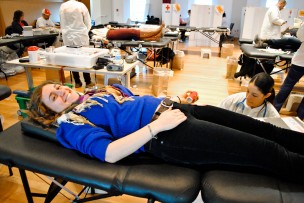On Feb. 5 and 6, students left Beckham Hall filled with a little more apple juice and a little less blood. The fluid swaps came as part of the University’s second Red Cross Blood Drive of the 2012-2013 school year. Despite obstacles including cuts to funding and a severe flu season, organizers collected 125 units of blood, a 14-unit increase from last semester’s collection.
Blood Drive Coordinator Jackie Freed ’15 organized, advertised, and oversaw Tuesday and Wednesday’s events. Freed noted that this year brought significant financial challenges.
“In the fall I was told that the Center for Community Partnerships, which had previously covered all blood drive expenses, could no longer afford to sponsor the collections,” Freed said. “This is another consequence of the University’s financial constraints. People don’t realize it’s not just need-blind financial aid being reduced; the budget is tight everywhere.”
Freed reached out to various organizations, and, through sponsorship from Phi Beta Sigma Fraternity (Wes Sigmas), the Inter-Greek Council, and the Wesleyan Student Assembly (WSA), was able to receive enough funding for this year’s drives.
The year’s highly virulent flu season has also challenged blood donations this winter.
“Fewer people are coming out to give blood due to personal infections or because they are taking care of others who are sick,” said Red Cross Account Manager Kim Moreland, who oversees the University’s blood drive.
To account for the expected decrease in donors, Freed and Moreland decided to double the hours of the blood drive in comparison to past drives.
Moreland, who organizes blood drives in 12 Connecticut communities, including Central Connecticut State University and Middletown Community College, observed a few demographic-related obstacles specific to the Wesleyan community.
“The girls at Wesleyan tend to be thinner than at other institutions,” Moreland said. “In order to give blood you have to have a certain height to weight ratio. Girls with smaller statures are less likely to be qualified donors. For this reason, at every Wesleyan blood drive, there are a number of young women we have to turn away.”
Moreland also noted that compared to other Connecticut institutions, Wesleyan has a higher percentage of international students and individuals who have studied or lived abroad in developing nations. This population further reduces the pool of individuals capable of giving blood.
Despite these challenges, the February blood drive nearly met its goal of 135 units, with 125 units of blood collected.
“Because the donations get separated into red blood cells, platelets and plasma, there are three potential recipients for each donation,” Moreland wrote in a follow-up email to The Argus. “If each donation is split into three, and each one goes to a different person, Wes helped 375 people in two days! Pretty cool.”
Moreland noted the spirited community she has encountered at the University blood drives.
“Wesleyan is a great community to work with,” said Moreland. “The students are always friendly and generous with their time.”
The blood collected at the University’s drive is sent to a Red Cross testing laboratory and then transferred to local Connecticut hospitals.
“Donating blood is a great way to give back to the community,” said Freed. “You can save someone’s life by donating just an hour of your time.”
Eli Halperin ’15, who gave blood on Feb. 5, agreed.
“Donating blood doesn’t harm me,” Halperin said. “I’ve never been close to passing out. I began giving blood in high school and have continued ever since.”
Steven Kovach ’13 noted the particular convenience of the University’s blood drives.
“[The drives] are geared toward students,” Kovach said. “Each is conveniently located and scheduled so everyone can participate.”
The next blood drive at the University will be held in April.
-
southerner
